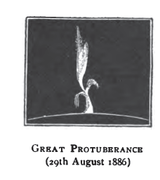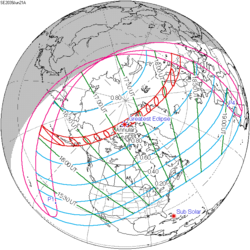| Total eclipse | |
| Gamma | −0.1059 |
|---|---|
| Magnitude | 1.0735 |
| Maximum eclipse | |
| Duration | 396 s (6 min 36 s) |
| Coordinates | 3°30′N15°18′W / 3.5°N 15.3°W |
| Max. width of band | 240 km (150 mi) |
| Times (UTC) | |
| Greatest eclipse | 12:55:23 |
| References | |
| Saros | 133 (38 of 72) |
| Catalog # (SE5000) | 9249 |
A total solar eclipse occurred at the Moon's ascending node of orbit on Sunday, August 29, 1886, with a magnitude of 1.0735. A solar eclipse occurs when the Moon passes between Earth and the Sun, thereby totally or partly obscuring the image of the Sun for a viewer on Earth. A total solar eclipse occurs when the Moon's apparent diameter is larger than the Sun's, blocking all direct sunlight, turning day into darkness. Totality occurs in a narrow path across Earth's surface, with the partial solar eclipse visible over a surrounding region thousands of kilometres wide. Occurring about 4 hours after perigee (on August 29, 1886, at 8:55 UTC), the Moon's apparent diameter was larger. [1]
Contents
- Observations
- Eclipse details
- Eclipse season
- Related eclipses
- Eclipses in 1886
- Metonic
- Tzolkinex
- Half-Saros
- Tritos
- Solar Saros 133
- Inex
- Triad
- Solar eclipses of 1884–1888
- Saros 133
- Metonic series
- Tritos series
- Inex series
- References
The path of totality was visible from parts of modern-day Panama, Colombia, Venezuela, Grenada, Tobago, Saint Vincent and the Grenadines, Barbados, Angola, Zambia, Zimbabwe, Mozambique, and Madagascar. A partial solar eclipse was also visible for parts of eastern North America, Central America, the Caribbean, northern South America, and Africa.












































































































